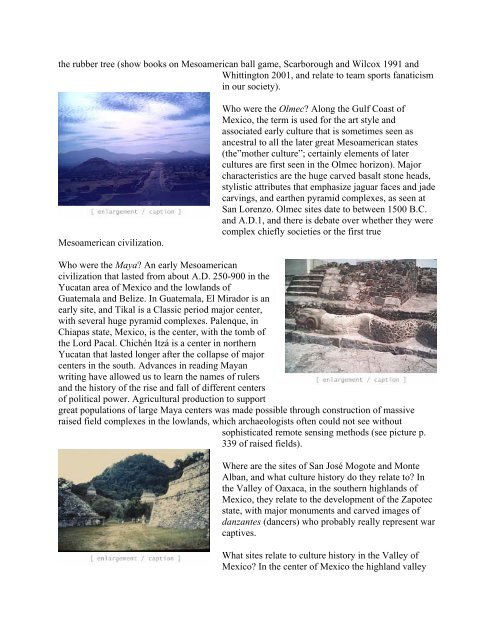INTRODUCTION TO ARCHAEOLOGY Nancy White - Touro Institute
INTRODUCTION TO ARCHAEOLOGY Nancy White - Touro Institute
INTRODUCTION TO ARCHAEOLOGY Nancy White - Touro Institute
Create successful ePaper yourself
Turn your PDF publications into a flip-book with our unique Google optimized e-Paper software.
the rubber tree (show books on Mesoamerican ball game, Scarborough and Wilcox 1991 and<br />
Whittington 2001, and relate to team sports fanaticism<br />
in our society).<br />
Mesoamerican civilization.<br />
Who were the Olmec? Along the Gulf Coast of<br />
Mexico, the term is used for the art style and<br />
associated early culture that is sometimes seen as<br />
ancestral to all the later great Mesoamerican states<br />
(the”mother culture”; certainly elements of later<br />
cultures are first seen in the Olmec horizon). Major<br />
characteristics are the huge carved basalt stone heads,<br />
stylistic attributes that emphasize jaguar faces and jade<br />
carvings, and earthen pyramid complexes, as seen at<br />
San Lorenzo. Olmec sites date to between 1500 B.C.<br />
and A.D.1, and there is debate over whether they were<br />
complex chiefly societies or the first true<br />
Who were the Maya? An early Mesoamerican<br />
civilization that lasted from about A.D. 250-900 in the<br />
Yucatan area of Mexico and the lowlands of<br />
Guatemala and Belize. In Guatemala, El Mirador is an<br />
early site, and Tikal is a Classic period major center,<br />
with several huge pyramid complexes. Palenque, in<br />
Chiapas state, Mexico, is the center, with the tomb of<br />
the Lord Pacal. Chichén Itzá is a center in northern<br />
Yucatan that lasted longer after the collapse of major<br />
centers in the south. Advances in reading Mayan<br />
writing have allowed us to learn the names of rulers<br />
and the history of the rise and fall of different centers<br />
of political power. Agricultural production to support<br />
great populations of large Maya centers was made possible through construction of massive<br />
raised field complexes in the lowlands, which archaeologists often could not see without<br />
sophisticated remote sensing methods (see picture p.<br />
339 of raised fields).<br />
Where are the sites of San José Mogote and Monte<br />
Alban, and what culture history do they relate to? In<br />
the Valley of Oaxaca, in the southern highlands of<br />
Mexico, they relate to the development of the Zapotec<br />
state, with major monuments and carved images of<br />
danzantes (dancers) who probably really represent war<br />
captives.<br />
What sites relate to culture history in the Valley of<br />
Mexico? In the center of Mexico the highland valley
















